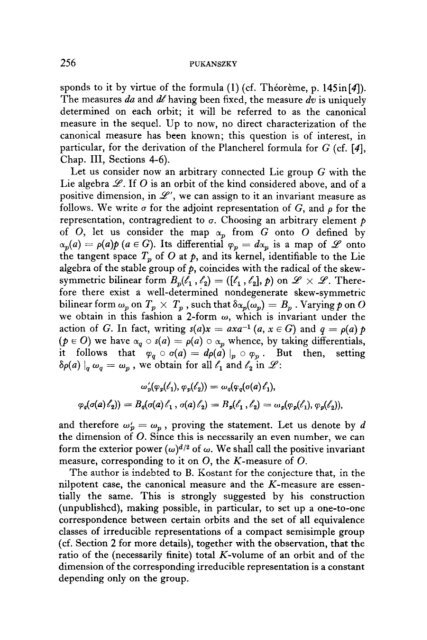On the Characters and the Plancherel Formula of Nilpotent Groups ...
On the Characters and the Plancherel Formula of Nilpotent Groups ...
On the Characters and the Plancherel Formula of Nilpotent Groups ...
You also want an ePaper? Increase the reach of your titles
YUMPU automatically turns print PDFs into web optimized ePapers that Google loves.
256 PUKANSZKY<br />
sponds to it by virtue <strong>of</strong> <strong>the</strong> formula (1) (cf. Theo&me, p. 145in[4]).<br />
The measures da <strong>and</strong> dr! having been fixed, <strong>the</strong> measure dv is uniquely<br />
determined on each orbit; it will be referred to as <strong>the</strong> canonical<br />
measure in <strong>the</strong> sequel. Up to now, no direct characterization <strong>of</strong> <strong>the</strong><br />
canonical measure has been known; this question is <strong>of</strong> interest, in<br />
particular, for <strong>the</strong> derivation <strong>of</strong> <strong>the</strong> <strong>Plancherel</strong> formula for G (cf. [4],<br />
Chap. III, Sections 4-6).<br />
Let us consider now an arbitrary connected Lie group G with <strong>the</strong><br />
Lie algebra 9’. If 0 is an orbit <strong>of</strong> <strong>the</strong> kind considered above, <strong>and</strong> <strong>of</strong> a<br />
positive dimension, in 9’, we can assign to it an invariant measure as<br />
follows. We write 0 for <strong>the</strong> adjoint representation <strong>of</strong> G, <strong>and</strong> p for <strong>the</strong><br />
representation, contragredient to o. Choosing an arbitrary element p<br />
<strong>of</strong> 0, let us consider <strong>the</strong> map CX~ from G onto 0 defined by<br />
a,(a) = p(a)p (a E G). Its differential vp = da+, is a map <strong>of</strong> 5’ onto<br />
<strong>the</strong> tangent space TP <strong>of</strong> 0 at p, <strong>and</strong> its kernel, identifiable to <strong>the</strong> Lie<br />
algebra <strong>of</strong> <strong>the</strong> stable group <strong>of</strong> p, coincides with <strong>the</strong> radical <strong>of</strong> <strong>the</strong> skewsymmetric<br />
bilinear form B,(tr ,8s) = ([/i , es], p) on 9 x 3’. Therefore<br />
<strong>the</strong>re exist a well-determined nondegenerate skew-symmetric<br />
bilinear form wp on TP x TP , such that A,(,) = BP . Varyingp on 0<br />
we obtain in this fashion a 2-form w, which is invariant under <strong>the</strong><br />
action <strong>of</strong> G. In fact, writing s(a)x = axa-l (a, x E G) <strong>and</strong> q = p(a)p<br />
(p E 0) we have mp o s(a) = p(a) o ap whence, by taking differentials,<br />
it follows that CJ.I* o u(a) = dp(a) Ip o vp . But <strong>the</strong>n, setting<br />
Ma) lp up = up , we obtain for all &, <strong>and</strong> tZ in 9:<br />
4%(6)7 %(a = %M44 4),<br />
<strong>and</strong> <strong>the</strong>refore w; = op , p roving <strong>the</strong> statement. Let us denote by d<br />
<strong>the</strong> dimension <strong>of</strong> 0. Since this is necessarily an even number, we can<br />
form <strong>the</strong> exterior power (w)~/~ <strong>of</strong> w. We shall call <strong>the</strong> positive invariant<br />
measure, corresponding to it on 0, <strong>the</strong> K-measure <strong>of</strong> 0.<br />
The author is indebted to B. Kostant for <strong>the</strong> conjecture that, in <strong>the</strong><br />
nilpotent case, <strong>the</strong> canonical measure <strong>and</strong> <strong>the</strong> K-measure are essen-<br />
tially <strong>the</strong> same. This is strongly suggested by his construction<br />
(unpublished), making possible, in particular, to set up a one-to-one<br />
correspondence between certain orbits <strong>and</strong> <strong>the</strong> set <strong>of</strong> all equivalence<br />
classes <strong>of</strong> irreducible representations <strong>of</strong> a compact semisimple group<br />
(cf. Section 2 for more details), toge<strong>the</strong>r with <strong>the</strong> observation, that <strong>the</strong><br />
ratio <strong>of</strong> <strong>the</strong> (necessarily finite) total K-volume <strong>of</strong> an orbit <strong>and</strong> <strong>of</strong> <strong>the</strong><br />
dimension <strong>of</strong> <strong>the</strong> corresponding irreducible representation is a constant<br />
depending only on <strong>the</strong> group.

















